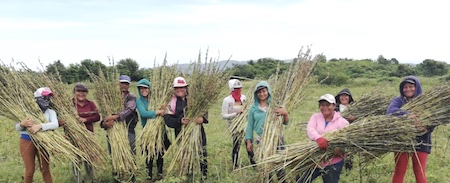In 1999, when I first came to Ciudad Sandino, a city of 180,000 located just outside Managua, Hurricane Mitch had recently created 2.7 million homeless people in Nicaragua and Honduras. The neoliberal government had pocketed the aid that came into the country. Ciudad Sandino had received 12,000 hurricane refugees who were living in black plastic tents, but those who had been living in Ciudad Sandino for decades weren’t in much better shape: most houses were walled with scrap wood and plastic. There was only one paved road in the city. Neighbourhoods had only sporadic access to water, no sewage system and most homes weren’t connected to the electrical grid with its frequent blackouts. The only hospital sat empty with no medicines or supplies. Children had to bring their own desks if they wanted to go to school. Very few people had formal jobs and farmers rented land to large agribusiness because they couldn’t afford to plant their own fields. The neoliberal Nicaragua I’m describing is unrecognisable from the Nicaragua of today. In just 14 years since the return of the Sandinista government in 2007, extreme poverty has dropped by 23.4 per cent. How has this been done? The Nicaraguan government has implemented a new model of development. Healthcare: Nicaragua has built 21 new hospitals and remodelled 46 more. It has built or remodelled 1,259 medical posts, 192 health centres and 178 maternity homes. Additionally, it has equipped 66 mobile clinics made from converted articulated trucks confiscated in drug busts; in 2020 these mobile clinics provided nearly 1.9 million consultations. All this, combined with the school lunch programme which guarantees a hot meal of beans and rice to 1.2 million primary school children daily, there has been a 46 per cent reduction in chronic malnutrition in children under five and a 66 per cent reduction in chronic malnutrition in children aged six to 12 years old. Infant mortality rates have been lowered by 61 per cent and maternal mortality rates by 70 per cent. Education: In 2003, the average Nicaraguan had 3.5 years of schooling; only 30 per cent of those starting first grade were expected to finish 6th grade. Now, youth with no schooling at all has dropped from 24 per cent to 4 per cent. Rates for passing grades have increased from 79 per cent to 91 per cent and the population with a university degree has risen from 9 per cent to 19 per cent. Housing and land: Construction and improvements on 158,000 low-income houses and delivery of 427,434 land titles. An area equal to 31 per cent of Nicaragua’s national territory has been deeded to 314 indigenous communities in non-transferrable legal land titles. Basic services: In 2007 there were rolling blackouts and 80 per cent of Nicaragua’s energy was generated from oil. Today 80 per cent of Nicaragua’s electricity is produced using renewable resources and electrical coverage has risen from 54 per cent to 99 per cent. Access to potable water in urban areas has risen from 65 per cent to 92 per cent, in rural areas from 28 per cent to 55 per cent. Infrastructure: Nicaragua now boasts the best roads in the region, having doubled the mileage of paved roads, paving new nearly 2,000km, repairing another 2,000km. Agriculture: $548 million has been given in credits to small farmers, benefiting 25,700 farmers per year. Nearly 6,000 new co-operatives have been established benefiting 318,000 members; Nicaragua now produces 90 per cent of its own food. Creative economy: Small businesses account for 70 per cent of employment; 23,345 small businesses have been formalised, meaning those workers are now paid benefits and will be eligible for a retirement pension. 800,000 women have received loans representing $18 million per year at 5 per cent annual interest. Gender equality: According to the Global Gender Gap Report, in overall gender equality, Nicaragua has gone from 62 out of 153 countries in 2007 to number five worldwide, reducing the gender gap by over 80 per cent. Nicaragua is number one in the world in women’s health and survival, women’s educational attainment, and women cabinet ministers, and is number three in overall political empowerment of women. In the last 14 years, Nicaragua has become an example that the whole world urgently needs to follow: a model of equitable, green, pro-people development. Source URL |
